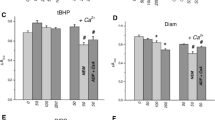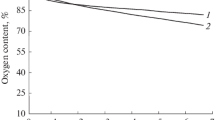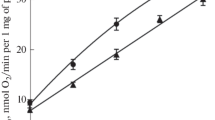Abstract
Diamide, a thiol oxidizing agent, partially inhibited P i uptake by rat liver mitochondria. The inhibition was temperature dependent; at 20°C, the optimal temperature for maximum inhibitory effect, diamide also reduced the minimal amount of mersalyl required for the inhibition of P i transport. Under the same conditions no inhibitory effect on P i efflux was observed. The amount of mitochondrial thiol groups titrated by the amounts of diamide needed for the inhibition of P i uptake was on the order of 5 nmole/mg protein. Unlike liver mitochondria, the P i transport system of heart mitochondria was insensitive to diamide. On the contrary, accumulation of P i into submitochondrial heart vesicles, previously loaded with MnCl2, was inhibited by diamide. These results outline the different positional character of membrane thiol groups of mitochondria from various sources, and provide further evidence of an asymmetric orientation of the P i transport system in mitochondrial membranes.
Similar content being viewed by others
References
A. Fonyo, E. Ligeti, F. Palmieri, and E. Quagliariello, in:Biomembranes, Structure and Function, G. Gardos and Y. Szasz eds., Akamiai Kiadó, Budapest, and North-Holland Publ., Amsterdam (1975) pp. 287–306.
D. Siliprandi, G. Scutari, F. Zoccarato, and N. Siliprandi,FEBS Lett. 42 (1974) 197.
T. R. Rhodin and E. Racker,Biochem. Biophys. Res. Commun. 64 (1974) 1207.
D. Siliprandi, A. Toninello, F. Zoccarato, and A. Bindoli,FEBS Lett. 51 (1975) 15.
W. C. Schneider, in:Manometric Techniques, W. W. Umbreit, R. Burris, and J. D. Stauffer, eds., Burgess Publishing Co., Minneapolis (1956) pp. 188–189.
S. V. Pande and M. C. Blanchaer,J. Biol. Chem. 246 (1971) 402.
A. L. Smith, in:Methods in Enzymology, Vol. X, R. W. Estabrook and M. E. Pullman, eds., (1967) p. 81.
S. Papa, D. Kanduc, and N. E. Lofrumento,FEBS Lett. 36 (1973) 9.
M. Klingenberg, R. Durand, and B. Guérin,Eur. J. Biochem. 42 (1974) 135.
O. Lindberg and L. Ernster, in:Methods of Biochemical Analysis, Vol. III, D. Glick, ed., Wiley-Interscience, New York (1956) pp. 1–22.
D. C. Gautheron,Biochimie 55 (1973) 249.
A. J. Meijer, G. S. P. Groot, and J. M. Tager,FEBS Lett. 8 (1970) 41.
J. B. Hoek, N. E. Lofrumento, A. J. Meyer, and J. M. Tager,Biochim. Biophys. Acta 226 (1971) 297.
D. E. Weiss,Experientia 29 (1973) 249.
Author information
Authors and Affiliations
Rights and permissions
About this article
Cite this article
Zoccarato, F., Rugolo, M. & Siliprandi, D. Phosphate transport in mitochondria and submitochondrial particles: The influence of thiol oxidation. J Bioenerg Biomembr 9, 203–212 (1977). https://doi.org/10.1007/BF00743194
Received:
Issue Date:
DOI: https://doi.org/10.1007/BF00743194




